Integrating Expert Assessments and Spectral Methods to Evaluate Visual Attractiveness and Ecosystem Services of Urban Informal Green Spaces in the Context of Climate Adaptation
Abstract
1. Introduction
- Develop a framework for assessing and distinguishing the most visually attractive IGSs, termed enchanted natural places (ENPs, or uroczyska miejskie in Polish).
- Explore the relationships between visual assessments and ecological attributes based on spectral and geospatial data.
2. Study Area and Data
2.1. Study Area
2.2. Geospatial and Remote Sensing Data
3. Methodology
3.1. The Research Path
3.2. Expert Assessments
- Landscape contrast, which is the visual contrast with the surrounding area [27,28,42]. This feature can increase the attractiveness of an enchanted natural place—for example, when spontaneous greenery in close proximity to buildings is encountered unexpectedly. The scores were given as follows: 5—very clear difference, contrast with anthropogenic elements (e.g., buildings, roads), and very clear differences in landforms; 4—clear difference with surrounding natural elements, (e.g., open area/wooded area) and clear contrast between landforms; 3—noticeable differences in land cover (for example, height of vegetation) and noticeable differences in landforms; 2—minor differences in nature of cover, such as different forest type, and no terrain differences; and 1—no apparent difference between the place and its surroundings;
- Naturalness, which is the similarity of the growing vegetation to the potential vegetation [10,25,26,29,42] found in Lublin [44]. The scores were given as follows: 5—very similar vegetation to natural communities and are multi-layered forest communities; 4—tall vegetation, trees, and self-sown plants, many of which are species typical for the habitat; 3—mixed areas, shrubland, low trees, bushes, grassland vegetation, and meadows; 2—area covered mostly with grassland vegetation, extensively used, and rarely mown; and 1—intensively used area and has been mowed;
- Uniqueness, which is the frequency of the occurrence of a given landscape type in the studied area [22,25,42]. This indicator was verified after the experts assessed all the sites. The scores were given as follows: 5—unique site (found once in the city); 4—very rare site (found 2–3 times); 3—rare site (found 4–6 times); 2—common site (7–10 times); and 1—very common site (occurring more than 10 times).
3.3. Spectral Indices
4. Results
4.1. Percentage of Built-Up Area in the Buffer
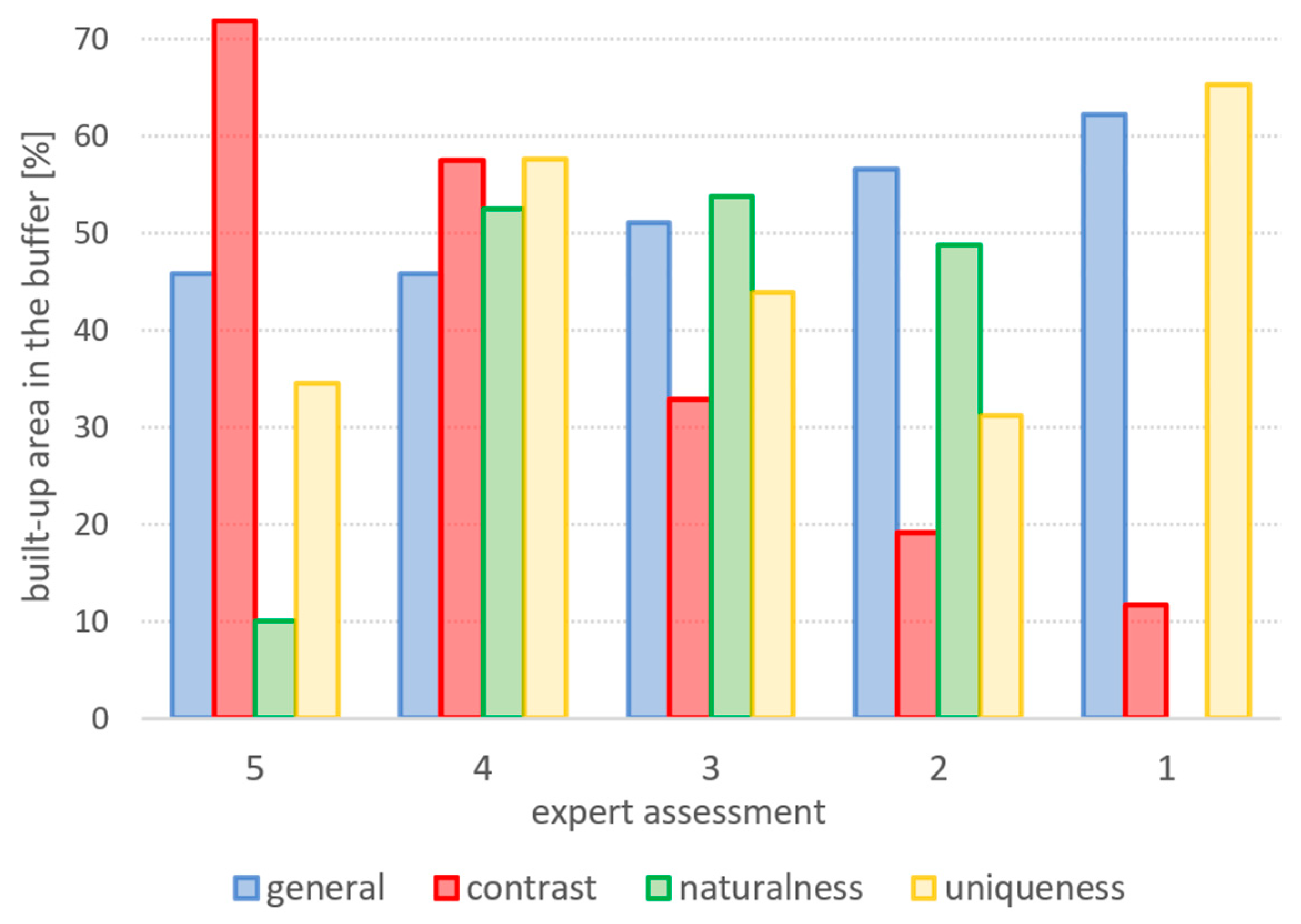
4.2. Relationships Between the Expert Assessments and Spectral Indices
| General Expert Assessment | Naturalness | Landscape Contrast | Uniqueness | |
|---|---|---|---|---|
| % share of built-up land in the buffer zone | The higher the rating, the less development they had | Only the highest-rated sites stood out—they had the least development | The higher the landscape contrast, the more built-up land in the buffer | The most prominent areas had relatively little development; no clear dependencies |
| LST | Cooler sites were rated higher but the coolest were rated 4; the higher-rated sites were also had a slightly higher temperature contrasted with the buffer | There was a slight tendency for sites with higher scores to be cooler; sites with a score of 5 clearly had a greater temperature difference with the buffer, while others showed a tendency for the reverse trend: the lower the naturalness, the greater the LST difference with the buffer | Reverse tendency—the higher the landscape contrast, the significantly warmer the site and the smaller its difference with that of the buffer | The higher rated area was noted for its uniqueness |
| NDVI | Sites which scored 4 were less spectacular and had the highest NDVI scores; higher-rated ones contrast less with the buffer, providing a sense of space | Sites with the highest scores for naturalness (5) had the highest NDVI score and those with significantly lower NDVI scores contrasted with the buffer; other sites had similar naturalness ratings and the NDVI differences increased slightly with decreasing naturalness | The lowest-rated sites had the highest NDVI scores; the smaller the landscape contrast, the smaller the difference in the index scores compared with the buffer (the environments were more similar) | The sites with the highest NDVI scores had average uniqueness (3 and 2); NDVI differences between the site and the buffer increased with decreasing uniqueness; there was also a significant difference for sites that scored a 4 |
| LAI | Sites which scored 4 were less spectacular and had the highest LAI scores; higher-rated ones contrasted less with the buffer, providing a sense of space | The sites with a naturalness score of 3 had the highest LAI scores; those with a naturalness score of 5 had the lowest LAI scores (but only slightly lower); sites with a significantly lower LAI score contrasted with the buffer; the greatest difference was observed for the areas that scored 2 for naturalness | Areas with the lowest value for contrast had the lowest LAI scores; the areas rated 4 or 3 stood out (average contrast); the smaller the landscape contrast, the smaller the LAI difference with the buffer | Average sites (uniqueness score of 3 and 2) had the highest LAI scores; lower scores for uniqueness correlated with increasing LAI differences between the site and buffer; a significant difference was also observed for the sites that scored a 4 |
| NDMI (moisture) | The most humid are areas were rated a 2; the higher-rated ones contrast less with the buffer | Sites rated higher for naturalness had slightly higher NDMI scores; sites with the highest scores for naturalness (5) had significantly smaller NDMI score differences; for the others, the humidity difference decreased as naturalness decreased | Sites with the lowest landscape contrast had the highest NDMI scores (5 and 4); the smaller the landscape contrast, the smaller the NDMI difference with the buffer | Sites rated 1 for uniqueness were the most humid; a decrease in uniqueness correlated with an increase in the difference between the site and the buffer; a significant difference was also observed for the sites that scored a 4 |
| Slope | Higher-rated sites had a greater slope and index difference between the terrain and the buffer; a rating of 2 stood out | The sites with the highest naturalness rating (5) had the lowest slope and the smallest difference with the buffer; the others showed the inverse—the lower the naturalness, the lower the slope and the smaller the difference; the highest value and slope difference were observed for the sites rated 4 | A higher landscape contrast means a higher slope and greater difference between the site and the buffer; the lowest slope and the smallest index difference were observed for the sites rated 2 | Sites with a uniqueness rating of 5, 4, or 3 had the highest slope and the greatest difference with the buffer, which were clearly distinguishable from the sites rated 2 or 1 |
| General Expert Assessment | Landscape Contrast | Naturalness | Uniqueness | |
|---|---|---|---|---|
| LST | −0.876 | 0.998 | −0.836 | −0.409 |
| LST difference | 0.623 | −0.760 | 0.708 | 0.037 |
| NDVI | 0.360 | −0.603 | 0.824 | −0.294 |
| NDVI difference | −0.937 | 0.950 | −0.897 | −0.714 |
| LAI | 0.177 | 0.761 | −0.566 | −0.517 |
| LAI difference | −0.958 | 0.983 | −0.862 | −0.573 |
| NDMI | 0.027 | −0.270 | 0.981 | −0.360 |
| NDMI difference | −0.738 | 0.956 | −0.633 | −0.564 |
| Slope | 0.813 | 0.918 | −0.347 | 0.740 |
| Slope difference | 0.799 | 0.881 | −0.246 | 0.757 |
| Built-up land | −0.968 | 0.984 | −0.726 | −0.284 |
- (a)
- LST—Land Surface Temperature
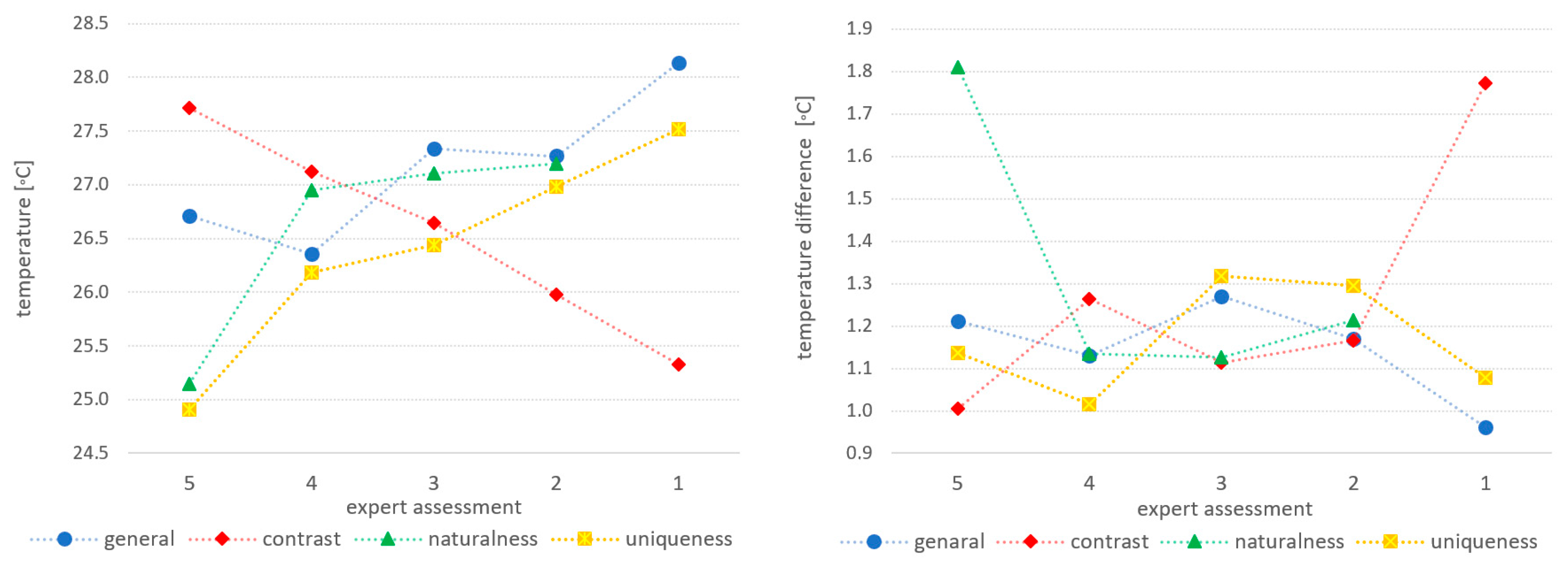
- (b)
- NDVI—Normalized Difference Vegetation Index
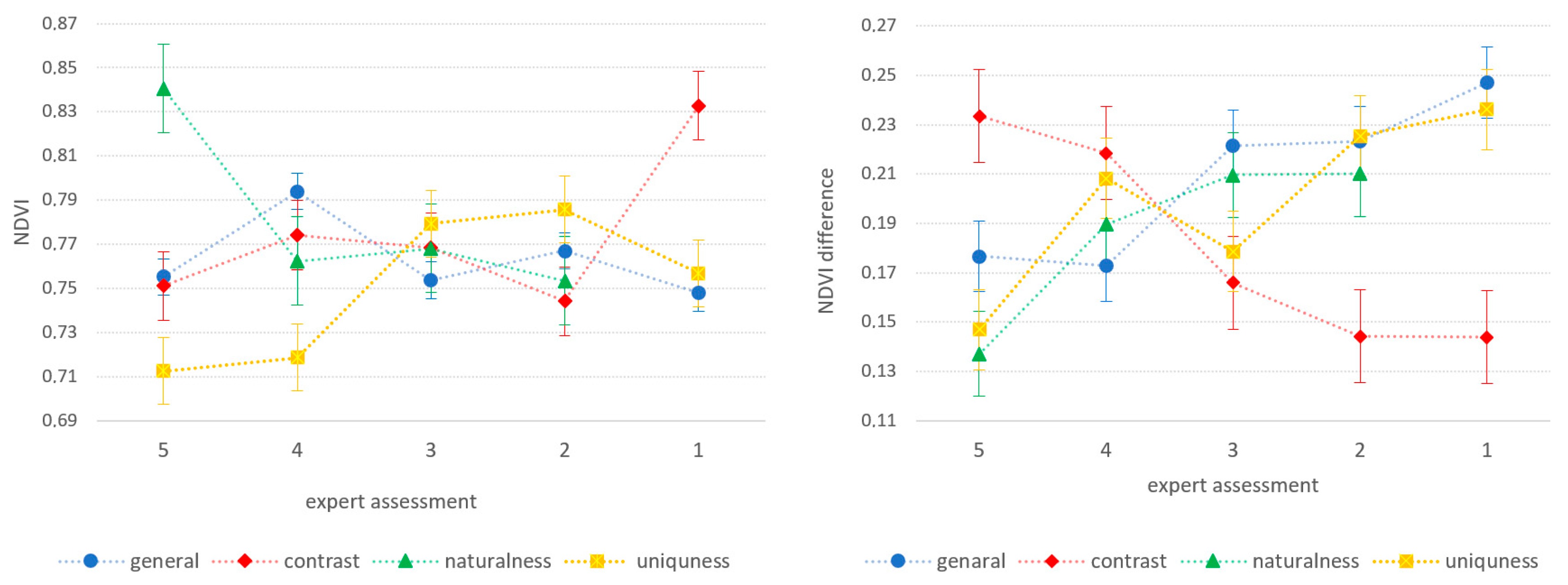
- (c)
- LAI—Leaf Area Index
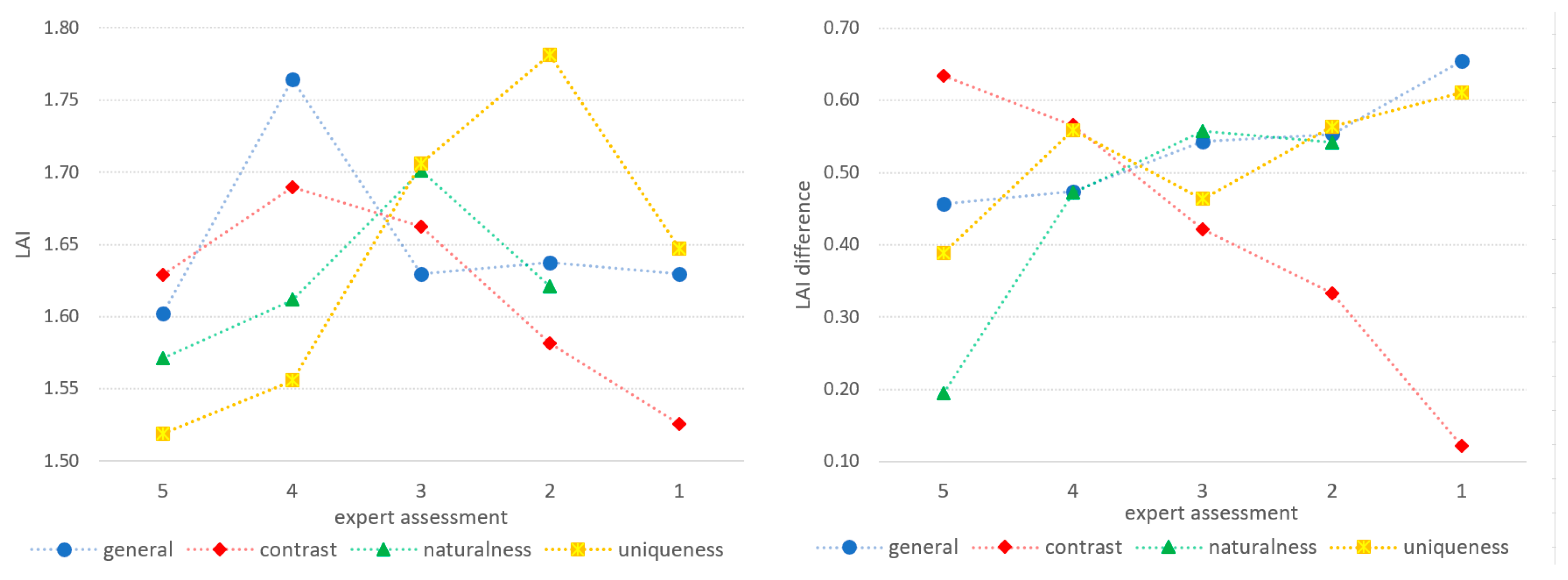
- (d)
- NDMI—Normalized Difference Moisture Index

- (e)
- Slope
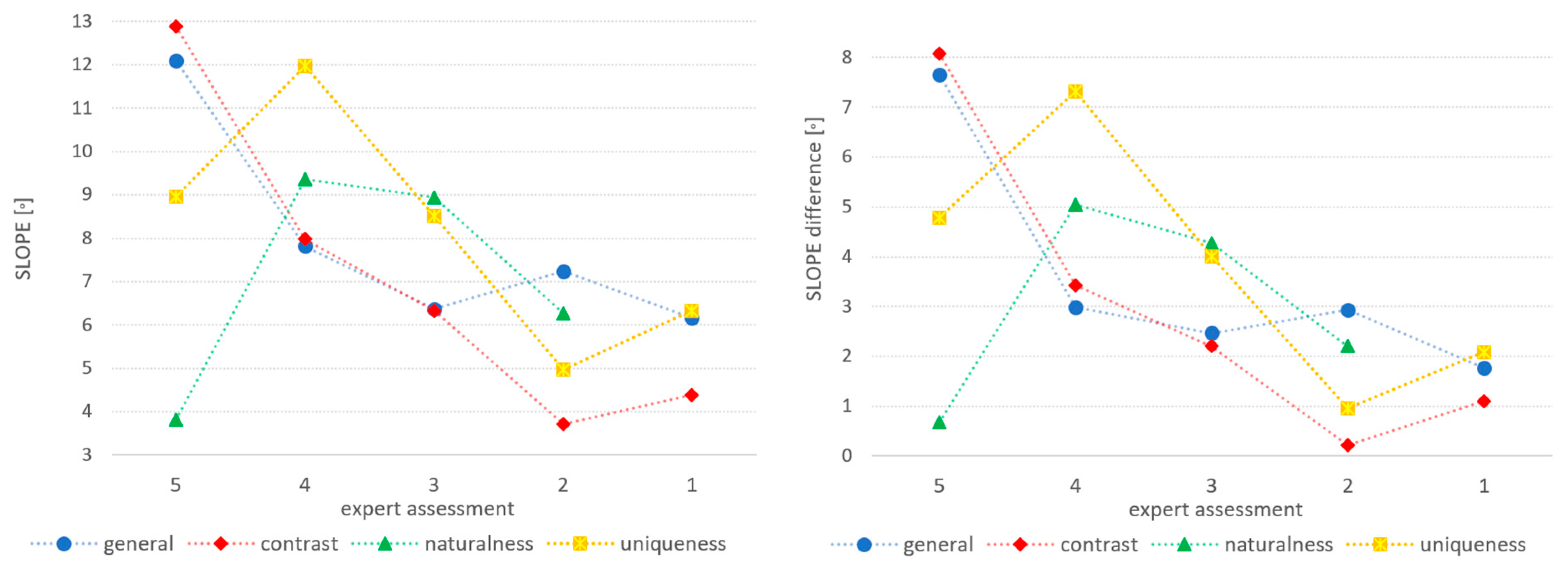
5. Discussion
6. Conclusions
Supplementary Materials
Author Contributions
Funding
Institutional Review Board Statement
Informed Consent Statement
Data Availability Statement
Conflicts of Interest
References
- Taylor, L.; Hochuli, D.F. Defining Greenspace: Multiple Uses across Multiple Disciplines. Landsc. Urban Plan. 2017, 158, 25–38. [Google Scholar] [CrossRef]
- Cvejić, R.; Eler, K.; Pintar, M.; Železnikar, Š.; Haase, D.; Kabisch, N.; Strohbach, M.W.; A Typology of Urban Green Spaces, Ecosystem Services Provisioning and Demands. KU Leuven. Available online: https://assets.centralparknyc.org/pdfs/institute/p2p-upelp/1.004_Greensurge_A+Typology+of+Urban+Green+Spaces.pdf (accessed on 4 February 2025).
- Gandy, M. Natura Urbana: Ecological Constellations in Urban Space; MIT Press: Cambridge, MA, USA, 2022; 416p. [Google Scholar]
- Edensor, T. Waste Matter—The Debris of Industrial Ruins and the Disordering of the Material World. J. Mater. Cult. 2005, 10, 311–332. [Google Scholar] [CrossRef]
- Braae, E.; Riesto, S. Designing Urban Natures: Ambiguities in Urban Space Design on the Threshold of Climate Disaster. Krit. Berichte Z. Kunst Kult. 2023, 45, 92–101. [Google Scholar] [CrossRef]
- Vicenzotti, V. Mapping Multivalent Metaphors: Analyzing the Wildnis Metaphor in the Zwischenstadt Discourse in Terms of Political Worldviews. Nat. Cult. 2013, 8, 162–184. [Google Scholar] [CrossRef]
- Rupprecht, C.D.D.; Byrne, J.A. Informal Urban Greenspace: A Typology and Trilingual Systematic Review of Its Role for Urban Residents and Trends in the Literature. Urban For. Urban Green. 2014, 13, 597–611. [Google Scholar] [CrossRef]
- Rupprecht, C.D.D.; Byrne, J.A.; Ueda, H.; Lo, A.Y. ‘It’s Real, Not Fake like a Park’: Residents’ Perception and Use of Informal Urban Green-Space in Brisbane, Australia and Sapporo, Japan. Landsc. Urban Plan. 2015, 143, 205–218. [Google Scholar] [CrossRef]
- Kowarik, I. Wild urban woodlands: Towards a conceptual framework. In Wild Urban Woodlands: New Perspectives for Urban Forestry; Springer: Berlin/Heidelberg, Germany, 2005; pp. 1–32. [Google Scholar] [CrossRef]
- Kowarik, I. Urban Wilderness: Supply, Demand, and Access. Urban For. Urban Green. 2018, 29, 336–347. [Google Scholar] [CrossRef]
- Sikorska, D.; Łaszkiewicz, E.; Krauze, K.; Sikorski, P. The Role of Informal Green Spaces in Reducing Inequalities in Urban Green Space Availability to Children and Seniors. Environ. Sci. Policy 2020, 108, 144–154. [Google Scholar] [CrossRef]
- Chen, H.; Deng, Q.; Zhou, Z.; Ren, Z.; Shan, X. Influence of Land Cover Change on Spatio-Temporal Distribution of Urban Heat Island—A Case in Wuhan Main Urban Area. Sustain. Cities Soc. 2022, 79, 103715. [Google Scholar] [CrossRef]
- Shah, A.; Garg, A.; Mishra, V. Quantifying the Local Cooling Effects of Urban Green Spaces: Evidence from Bengaluru, India. Landsc. Urban Plan. 2021, 209, 104043. [Google Scholar] [CrossRef]
- Cheng, L.; Guan, D.; Zhou, L.; Zhao, Z.; Zhou, J. Urban Cooling Island Effect of Main River on a Landscape Scale in Chongqing, China. Sustain. Cities Soc. 2019, 47, 101501. [Google Scholar] [CrossRef]
- Zheng, H.; Chen, Y.; Pan, W.; Cai, Y.; Chen, Z. Impact of Land Use/Land Cover Changes on the Thermal Environment in Urbanization: A Case Study of the Natural Wetlands Distribution in Minjiang River Estuary, China. Pol. J. Environ. Stud. 2019, 28, 3025–3041. [Google Scholar] [CrossRef]
- Ossola, A.; Jenerette, G.D.; McGrath, A.; Chow, W.; Hughes, L.; Leishman, M.R. Small Vegetated Patches Greatly Reduce Urban Surface Temperature during a Summer Heatwave in Adelaide, Australia. Landsc. Urban Plan. 2021, 209, 104046. [Google Scholar] [CrossRef]
- Preweda, E.; Jasińska, E. Organization of the Building Space of Developments and Its Impact on Residential Housing Prices. Sustainability 2020, 12, 7622. [Google Scholar] [CrossRef]
- Kremer, P.; Hamstead, Z.; Haase, D.; McPhearson, T.; Frantzeskaki, N.; Andersson, E.; Kabisch, N.; Larondelle, N.; Rall, E.L.; Voigt, A.; et al. Key Insights for the Future of Urban Ecosystem Services Research. Ecol. Soc. 2016, 21, 29. [Google Scholar] [CrossRef]
- Włodarczyk-Marciniak, R.; Sikorska, D.; Krauze, K. Residents’ Awareness of the Role of Informal Green Spaces in a Post-Industrial City, with a Focus on Regulating Services and Urban Adaptation Potential. Sustain. Cities Soc. 2020, 59, 102236. [Google Scholar] [CrossRef]
- Miao, X.; Pan, Y.; Chen, H.; Zhang, M.J.; Hu, W.; Li, Y.; Wu, R.; Wang, P.; Fang, S.; Niu, K.; et al. Understanding Spontaneous Biodiversity in Informal Urban Green Spaces: A Local-Landscape Filtering Framework with a Test on Wall Plants. Urban For. Urban Green. 2023, 86, 127996. [Google Scholar] [CrossRef]
- Henne, S.K. “New Wilderness” as an Element of the Peri-Urban Landscape. In Wild Urban Woodlands: New Perspectives for Urban Forestry; Springer: Berlin/Heidelberg, Germany, 2005; pp. 247–262. [Google Scholar] [CrossRef]
- Pietrzyk-Kaszyńska, A.; Czepkiewicz, M.; Kronenberg, J. Eliciting Non-Monetary Values of Formal and Informal Urban Green Spaces Using Public Participation GIS. Landsc. Urban Plan. 2017, 160, 85–95. [Google Scholar] [CrossRef]
- Kendal, D.; Ford, R.M.; Anderson, N.M.; Farrar, A. The VALS: A New Tool to Measure People’s General Valued Attributes of Landscapes. J. Environ. Manag. 2015, 163, 224–233. [Google Scholar] [CrossRef]
- Zhang, B.; Xie, G.; Gao, J.; Yang, Y. The Cooling Effect of Urban Green Spaces as a Contribution to Energy-Saving and Emission-Reduction: A Case Study in Beijing, China. Build. Environ. 2014, 76, 37–43. [Google Scholar] [CrossRef]
- Tveit, M.; Ode, Å.; Fry, G. Key Concepts in a Framework for Analysing Visual Landscape Character. Landsc. Res. 2006, 31, 229–255. [Google Scholar] [CrossRef]
- Ode, Å.; Fry, G.; Tveit, M.S.; Messager, P.; Miller, D. Indicators of Perceived Naturalness as Drivers of Landscape Preference. J. Environ. Manag. 2009, 90, 375–383. [Google Scholar] [CrossRef] [PubMed]
- Rink, D.; Emmrich, R. Surrogate Nature or Wilderness? Social Perceptions and Notions of Nature in an Urban Context. In Wild Urban Woodlands: New Perspectives for Urban Forestry; Springer: Berlin/Heidelberg, Germany, 2005; pp. 67–80. [Google Scholar] [CrossRef]
- Kerebel, A.; Gélinas, N.; Déry, S.; Voigt, B.; Munson, A. Landscape Aesthetic Modelling Using Bayesian Networks: Conceptual Framework and Participatory Indicator Weighting. Landsc. Urban Plan. 2019, 185, 258–271. [Google Scholar] [CrossRef]
- Carver, S.; Comber, A.; McMorran, R.; Nutter, S. A GIS Model for Mapping Spatial Patterns and Distribution of Wild Land in Scotland. Landsc. Urban Plan. 2012, 104, 395–409. [Google Scholar] [CrossRef]
- Müller, A.; Bøcher, P.K.; Svenning, J.C. Where Are the Wilder Parts of Anthropogenic Landscapes? A Mapping Case Study for Denmark. Landsc. Urban Plan. 2015, 144, 90–102. [Google Scholar] [CrossRef]
- Yang, C.; He, X.; Wang, R.; Yan, F.; Yu, L.; Bu, K.; Yang, J.; Chang, L.; Zhang, S. The Effect of Urban Green Spaces on the Urban Thermal Environment and Its Seasonal Variations. Forests 2017, 8, 153. [Google Scholar] [CrossRef]
- Zhu, X.; Wang, X.; Yan, D.; Liu, Z.; Zhou, Y. Analysis of Remotely-Sensed Ecological Indexes’ Influence on Urban Thermal Environment Dynamic Using an Integrated Ecological Index: A Case Study of Xi’an, China. Int. J. Remote Sens. 2019, 40, 3421–3447. [Google Scholar] [CrossRef]
- Sun, X.; Tan, X.; Chen, K.; Song, S.; Zhu, X.; Hou, D. Quantifying Landscape-Metrics Impacts on Urban Green-Spaces and Water-Bodies Cooling Effect: The Study of Nanjing, China. Urban For. Urban Green. 2020, 55, 126838. [Google Scholar] [CrossRef]
- Hauser, L.T.; Féret, J.B.; Binh, N.A.; van der Windt, N.; Sil, Â.F.; Timmermans, J.; Soudzilovskaia, N.A.; van Bodegom, P.M. Towards Scalable Estimation of Plant Functional Diversity from Sentinel-2: In-Situ Validation in a Heterogeneous (Semi-)Natural Landscape. Remote Sens. Environ. 2021, 262, 112505. [Google Scholar] [CrossRef]
- Statistics Poland—Local Data Bank. Statistics Poland, Warsaw. Available online: https://bdl.stat.gov.pl (accessed on 4 February 2025).
- Florgård, C. Preserved and Remnant Natural Vegetation in Cities: A Geographically Divided Field of Research. Landsc. Res. 2007, 32, 79–94. [Google Scholar] [CrossRef]
- EarthExplorer Data Platform. U.S. Geological Survey. Available online: https://earthexplorer.usgs.gov (accessed on 4 February 2025).
- Landsat 8|U.S. Geological Survey. Available online: https://www.usgs.gov/core-science-systems/nli/landsat/landsat-8 (accessed on 4 February 2025).
- Catalyst.Earth Catalyst Professional: ATCOR Module. Catalyst Geospatial Software. Available online: https://catalyst.earth/products/catalyst-pro/ (accessed on 4 February 2025).
- Zevenbergen, L.W.; Thorne, C.R. Quantitative Analysis of Land Surface Topography. Earth Surf. Process. Landf. 1987, 12, 47–56. [Google Scholar] [CrossRef]
- Copernicus. Urban Atlas 2018. Copernicus Land Monitoring Service. Available online: https://land.copernicus.eu/local/urban-atlas (accessed on 4 February 2025).
- Ode, Å.; Tveit, M.; Fry, G. Capturing Landscape Visual Character Using Indicators: Touching Base with Landscape Aesthetic Theory. Landsc. Res. 2008, 33, 89–117. [Google Scholar] [CrossRef]
- Feltynowski, M.; Kronenberg, J.; Bergier, T.; Kabisch, N.; Łaszkiewicz, E.; Strohbach, M.W. Challenges of Urban Green Space Management in the Face of Using Inadequate Data. Urban For. Urban Green. 2018, 31, 56–66. [Google Scholar] [CrossRef]
- Matuszkiewicz, J.M. Potencjalna Roślinność Naturalna Polski (Potential Natural Vegetation of Poland); IGiPZ PAN: Warszawa, Poland, 2008. [Google Scholar]
- Ashihara, Y. Exterior Design in Architecture; Van Nostrand Reinhold Company: New York, NY, USA, 1970. [Google Scholar]
- Bogdanowski, J.; Łuczyńska-Bruzda, M.; Novák, Z. Architektura Krajobrazu (Landscape Architecture); PWN: Warszawa/Kraków, Poland, 1979. [Google Scholar]
- Müller, A.; Bøcher, P.K.; Fischer, C.; Svenning, J.C. ‘Wild’ in the City Context: Do Relative Wild Areas Offer Opportunities for Urban Biodiversity? Landsc. Urban Plan. 2018, 170, 256–265. [Google Scholar] [CrossRef]
- Rouse, J.W., Jr.; Haas, R.H.; Deering, D.W.; Schell, J.A.; Harlan, J.C. Monitoring the Vernal Advancement and Retrogradation (Green Wave Effect) of Natural Vegetation; Remote Sensing Center, Texas A&M University: College Station, TX, USA, 1974. [Google Scholar]
- Kimm, H.; Ryu, Y. Seasonal Variations in Photosynthetic Parameters and Leaf Area Index in an Urban Park. Urban For. Urban Green. 2015, 14, 1059–1067. [Google Scholar] [CrossRef]
- Wang, Q.; Adiku, S.; Tenhunen, J.; Granier, A. On the Relationship of NDVI with Leaf Area Index in a Deciduous Forest Site. Remote Sens. Environ. 2005, 94, 244–255. [Google Scholar] [CrossRef]
- Boegh, E.; Soegaard, H.; Broge, N.; Schelde, K.; Thomsen, A.; Hasager, C.B.; Jensen, N.O. Airborne Multispectral Data for Quantifying Leaf Area Index, Nitrogen Concentration, and Photosynthetic Efficiency in Agriculture. Remote Sens. Environ. 2002, 81, 179–193. [Google Scholar] [CrossRef]
- Öpik, H.; Rolfe, S.A.; Willis, A.J. The Physiology of Flowering Plants. In The Physiology of Flowering Plants, 4th ed.; Cambridge University Press: Cambridge, UK, 2005; pp. 1–392. [Google Scholar] [CrossRef]
- Jenerette, G.D.; Harlan, S.L.; Stefanov, W.L.; Martin, C.A. Ecosystem Services and Urban Heat Riskscape Moderation: Water, Green Spaces, and Social Inequality in Phoenix, USA. Ecol. Appl. 2011, 21, 2637–2651. [Google Scholar] [CrossRef] [PubMed]
- Shi, D.; Song, J.; Huang, J.; Zhuang, C.; Guo, R.; Gao, Y. Synergistic Cooling Effects (SCEs) of Urban Green-Blue Spaces on Local Thermal Environment: A Case Study in Chongqing, China. Sustain. Cities Soc. 2020, 55, 102065. [Google Scholar] [CrossRef]
- Inostroza, L. Open Spaces and Urban Ecosystem Services. Cooling Effect towards Urban Planning in South American Cities. TeMA—J. Land Use Mobil. Environ. 2014. Available online: https://www.researchgate.net/publication/307782613_Open_Spaces_and_Urban_Ecosystem_Services_Cooling_Effect_towards_Urban_Planning_in_South_American_Cities (accessed on 4 February 2025).


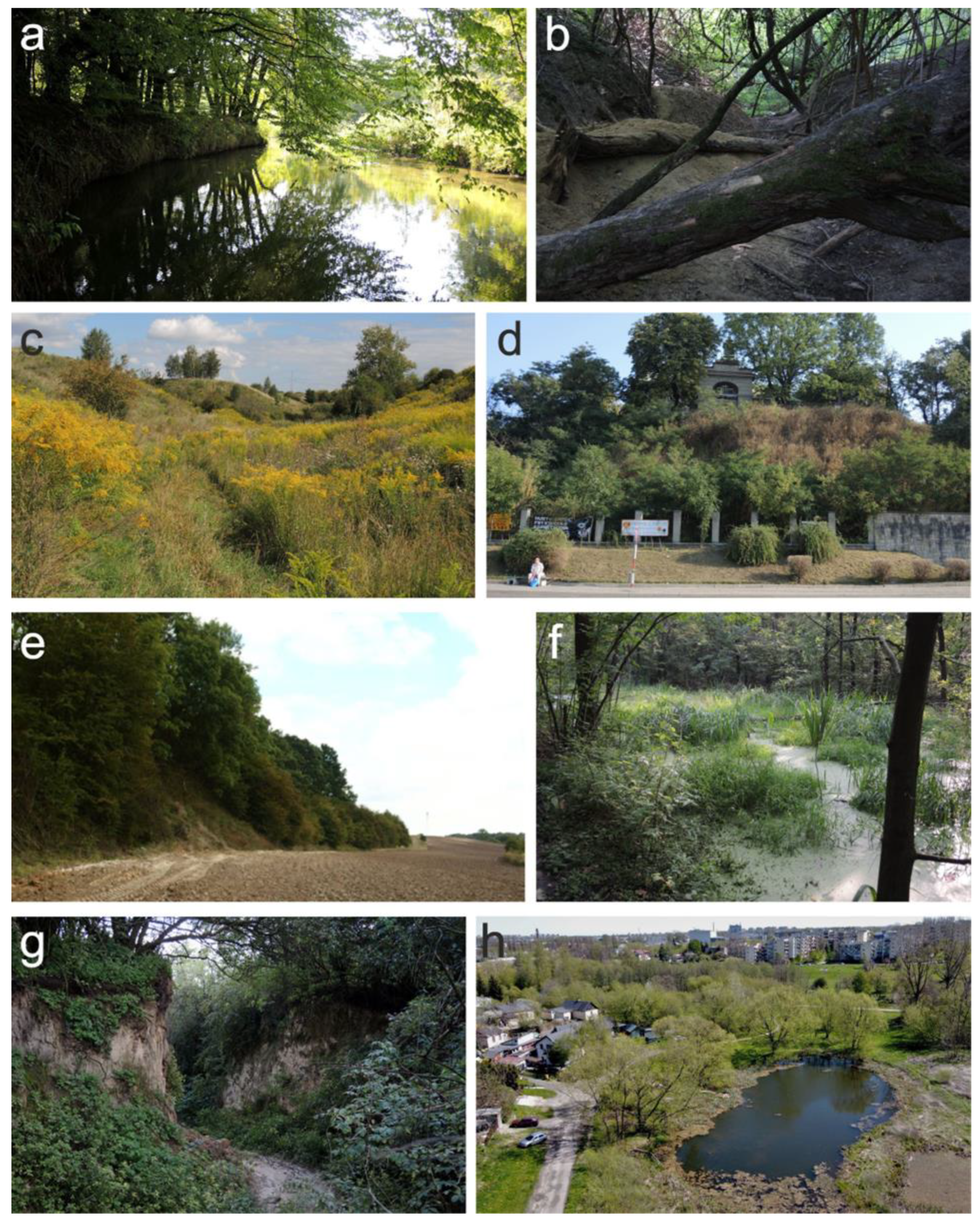
| Parameter | |
|---|---|
| ENP surface | m2 |
| Surface of the buffer | m2 |
| Built-up land in the buffer | % |
| Naturalness | 5–1 |
| Landscape contrast | 5–1 |
| Uniqueness | 5–1 |
| Main landform type | F—flat; S—slope; G—gorge; V—valley; B—valley bottom; E—escarpment; P—plateau; H—hill |
| Main type of landcover | T—trees; S—shrubs; H—grass/herbaceous; M—mixed |
| Landscape composition | E—enclosure; M—massif; X—exposed; U—unclear |
| % of enclosure | % |
| Number of human artefacts in sight | +/− |
| Interesting landform | +/− |
| Presence of water | +/− |
| Distant view | +/− |
| Diversity of plant forms | +/− |
| Diversity of plans height | +/− |
| Presence of old trees | +/− |
| Screened-off, hidden place | +/− |
| “Visual access” from the outside | +/− |
| Usage | 5—none; 4—single path; 3—single road; 2—several paths; 1—dense path network |
| Name | |
| General expert assessment | 1–5 |
| Image of Research Site | No. and Description |
|---|---|
 | 19. Gorge beside Szczytowa Str. Unique small loess gorge; with water erosion; closely surrounded by dense housing estate. Expert assessment: general—5; naturalness—4; uniqueness—5; landscape contrast—5; buildings in buffer—73.8%; enclosure—100%; low number of human artefacts in sight; interesting landform; diversity of plant forms; diversity of plants height; screened-off/hidden place; usage—5 (none); example of ENP. |
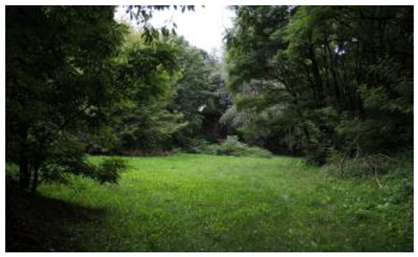 | 14. Gorge beside Uśmiechu Str. Gorge; partly changed by earthworks; occasionally mowed; surrounded by housing estate. Expert assessment: general—4; naturalness—3; uniqueness—4; landscape contrast—4; buildings in buffer—53.4%; enclosure—75%; low number of human artefacts in sight; interesting landform; diversity of plant forms; diversity of plants height; visual access from outside; usage—4 (single path); example of ENP. |
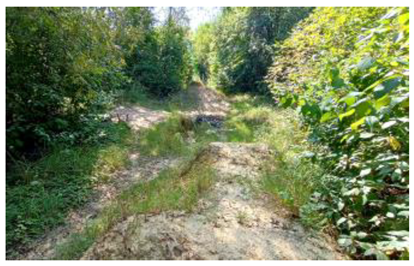 | 32. Planned park beside Gnieźnieńska Str. Area spontaneously covered by dense trees and shrubs, with informal pathways and constructions for trail bikes. Expert assessment: general—3; naturalness—3; uniqueness—1; landscape contrast—5; buildings in buffer—80.1%; massif; diversity of plant forms; diversity of plants height; screened-off/hidden place; usage—2 (several paths); example of ENP. |
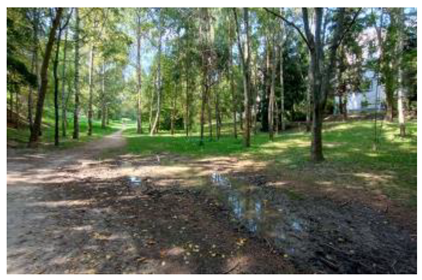 | 78. Valley “Globus” Dry valley, covered by trees, with small number of shrubs; regularly mowed; closely surrounded by housing estate; buildings are well visible from the site; occasionally wet. Expert assessment: general—2; naturalness—2; uniqueness—4; landscape contrast—5; buildings in buffer—81.7%; enclosure—75%; interesting landform; diversity of plants height; usage—3 (single road); some features of ENPs. |
 | 64. Shrubs close to Hospital No. 4 Flat area, covered by shrubs and small trees; surrounded by hospital buildings; buildings are very visible from the site. Expert assessment: general—1; naturalness—3; uniqueness—1; landscape contrast—5; buildings in buffer—77.7%; massif; diversity of plants height; visual access from outside; usage—2 (several paths); some features of ENPs. |
| Number of Sites | |||||
|---|---|---|---|---|---|
| Grade | General Assessment (Surface) | Naturalness | Landscape Contrast | Uniqueness | |
| ENP | 5 | 23 (278.3 ha) | 3 | 22 | 17 |
| ENP | 4 | 21 (236 ha) | 25 | 38 | 18 |
| ENP | 3 | 17 (58.4 ha) | 44 | 21 | 20 |
| Not ENP | 2 | 21 (43.8 ha) | 19 | 8 | 6 |
| Not ENP | 1 | 9 (18.4 ha) | 0 | 2 | 30 |
| All | 91 (634.9 ha) | ||||
Disclaimer/Publisher’s Note: The statements, opinions and data contained in all publications are solely those of the individual author(s) and contributor(s) and not of MDPI and/or the editor(s). MDPI and/or the editor(s) disclaim responsibility for any injury to people or property resulting from any ideas, methods, instructions or products referred to in the content. |
© 2025 by the authors. Licensee MDPI, Basel, Switzerland. This article is an open access article distributed under the terms and conditions of the Creative Commons Attribution (CC BY) license (https://creativecommons.org/licenses/by/4.0/).
Share and Cite
Kamiński, J.; Głowienka, E.; Soszyński, D.; Trzaskowska, E.; Stuczyński, T.; Siebielec, G.; Poręba, L. Integrating Expert Assessments and Spectral Methods to Evaluate Visual Attractiveness and Ecosystem Services of Urban Informal Green Spaces in the Context of Climate Adaptation. Sustainability 2025, 17, 1349. https://doi.org/10.3390/su17041349
Kamiński J, Głowienka E, Soszyński D, Trzaskowska E, Stuczyński T, Siebielec G, Poręba L. Integrating Expert Assessments and Spectral Methods to Evaluate Visual Attractiveness and Ecosystem Services of Urban Informal Green Spaces in the Context of Climate Adaptation. Sustainability. 2025; 17(4):1349. https://doi.org/10.3390/su17041349
Chicago/Turabian StyleKamiński, Jan, Ewa Głowienka, Dawid Soszyński, Ewa Trzaskowska, Tomasz Stuczyński, Grzegorz Siebielec, and Ludwika Poręba. 2025. "Integrating Expert Assessments and Spectral Methods to Evaluate Visual Attractiveness and Ecosystem Services of Urban Informal Green Spaces in the Context of Climate Adaptation" Sustainability 17, no. 4: 1349. https://doi.org/10.3390/su17041349
APA StyleKamiński, J., Głowienka, E., Soszyński, D., Trzaskowska, E., Stuczyński, T., Siebielec, G., & Poręba, L. (2025). Integrating Expert Assessments and Spectral Methods to Evaluate Visual Attractiveness and Ecosystem Services of Urban Informal Green Spaces in the Context of Climate Adaptation. Sustainability, 17(4), 1349. https://doi.org/10.3390/su17041349








